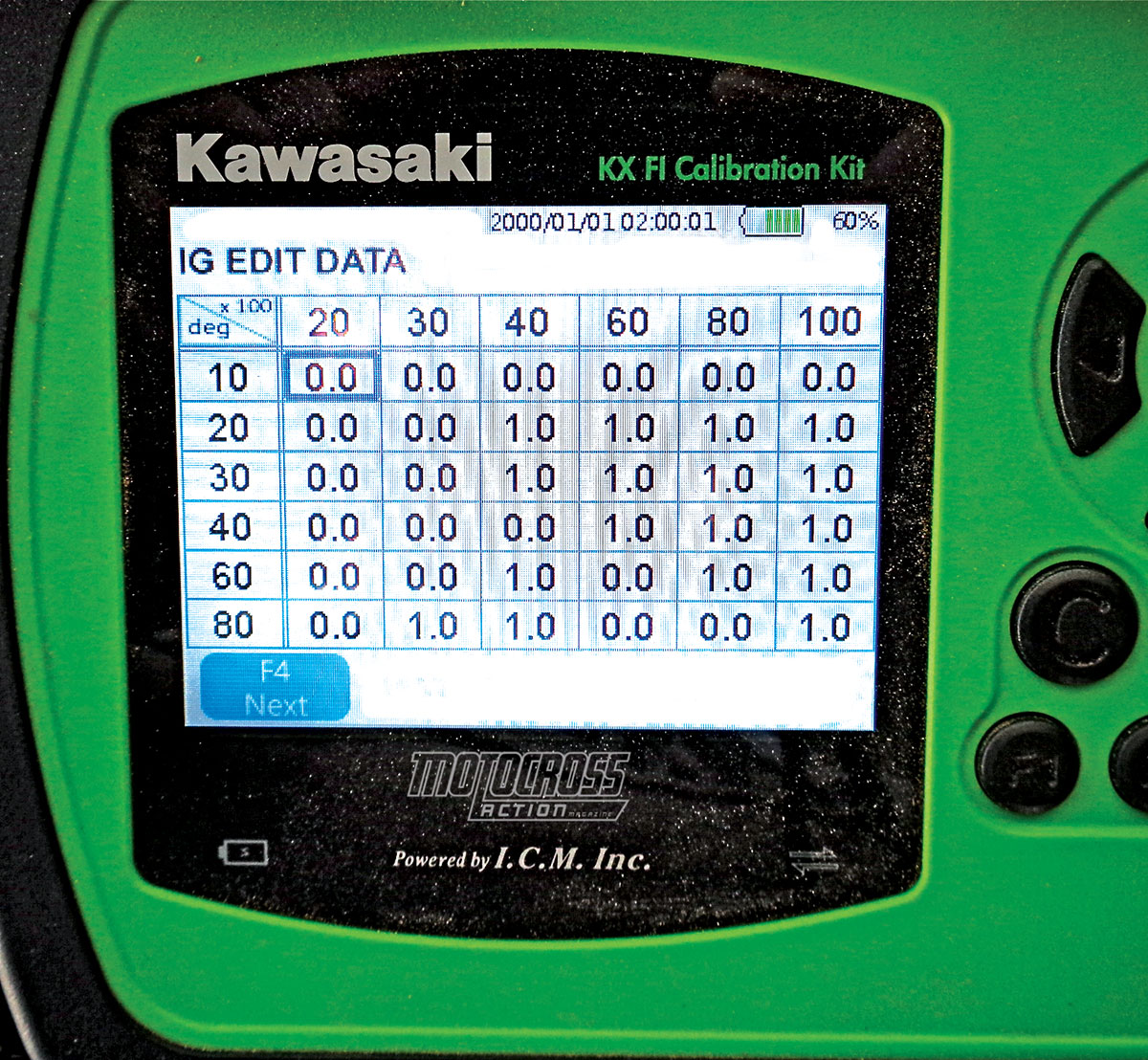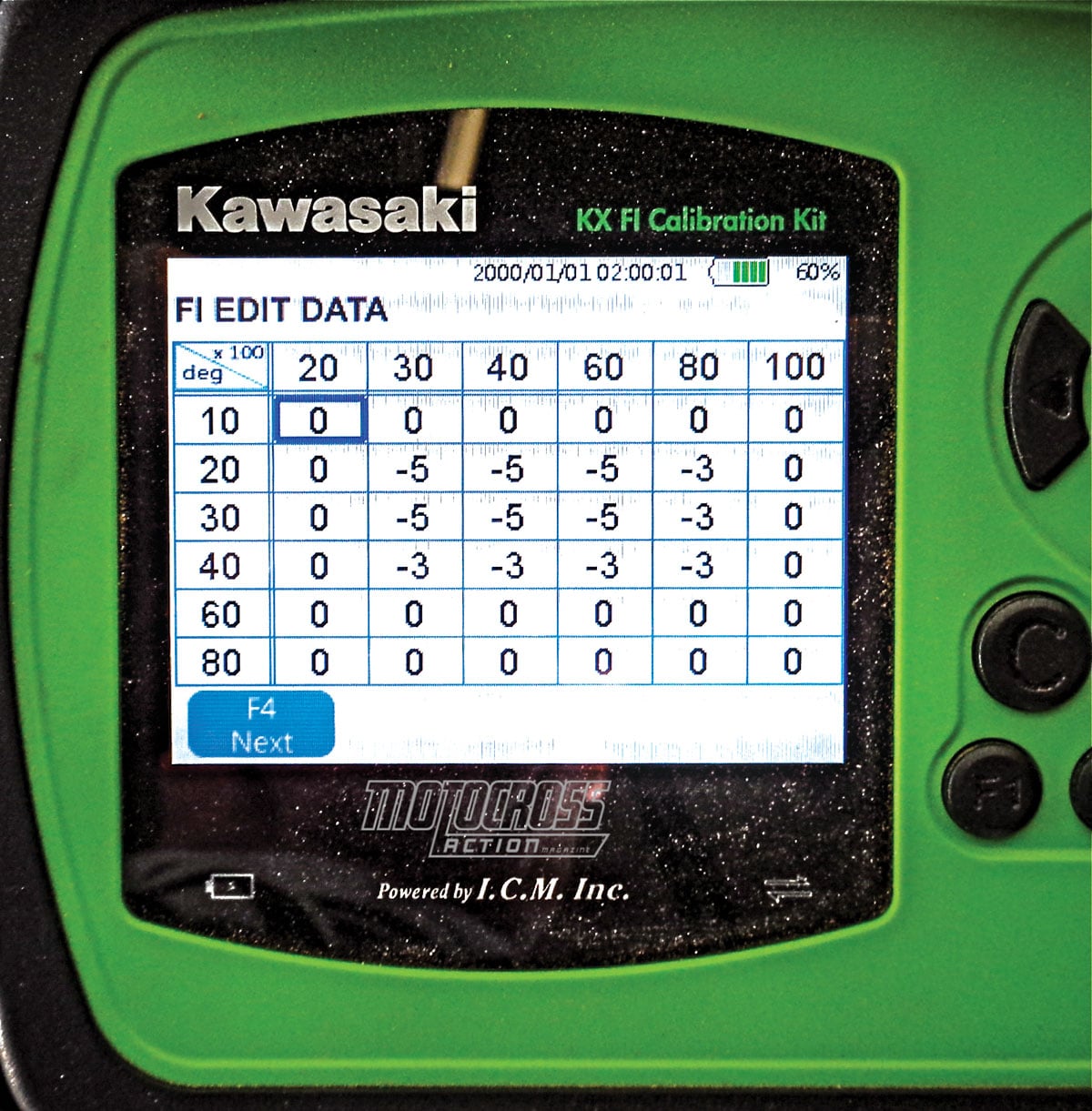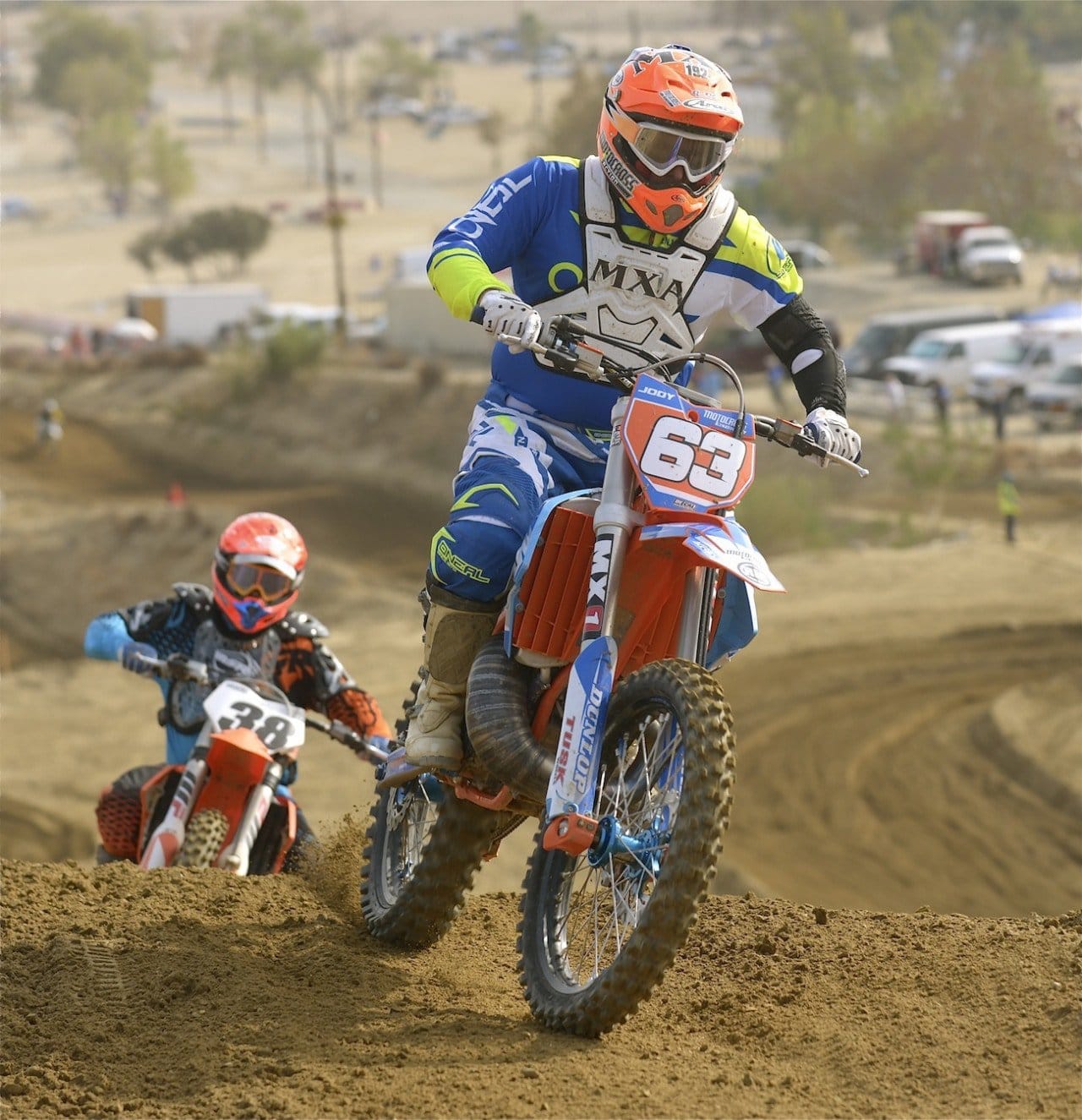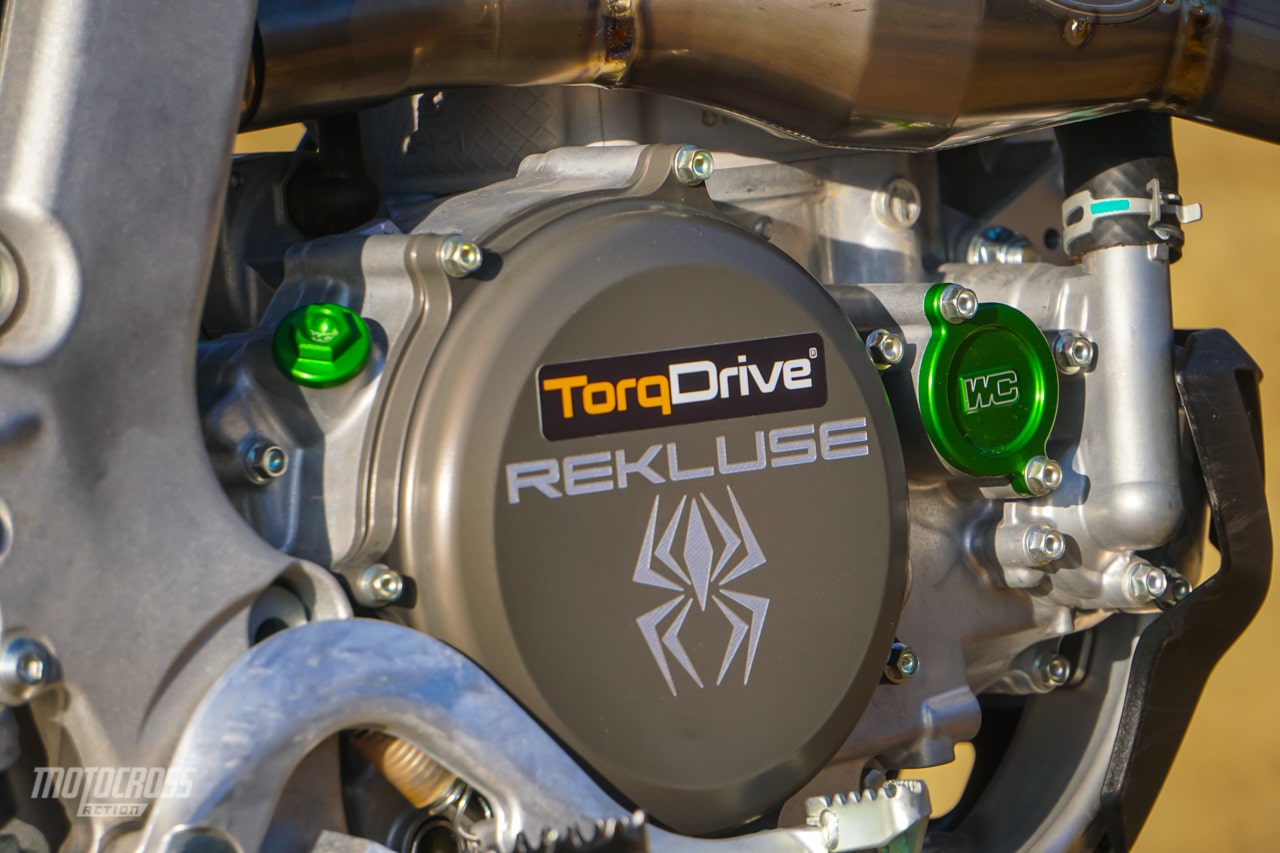WE RIDE DICKS RACING’S/MX1 PROJECT 2019 KAWASAKI KX450
Kawasaki turned the corner with the 2019 model year. Up to this point, Kawasaki had been treading water as KTM and Husqvarna moved farther and farther ahead of the Japanese brands. As KTMs got lighter, the Japanese brands got heavier. As KTM refined its hydraulic clutch and electric starting with each new model introduction, Honda, Yamaha, Suzuki and Kawasaki seemed bewildered by what was happening to them. Thankfully, Kawasaki has shown signs of life. Starting in 2019, Kawasaki started playing in the same league as the Austrian brands. The 2019 KX450 came with electric starting, a hydraulic clutch, side-mounted airbox, finger-followers and a weight that, while still 10 pounds heavier than the Austria duo, was 5 pounds lighter than the red, blue and yellow bikes. For 2019, Kawasaki has garnered buzz—not for defeating the might of KTM but for standing up to them.
SUDDENLY, KAWASAKI HAS THE ATTENTION OF MOTOCROSS RACERS WHO ARE WEARY OF AN ORANGE FUTURE.
Suddenly, Kawasaki has the attention of motocross racers who are weary of an orange future. Going green has become a cause celebre. And with Kawasaki’s newfound popularity have come aftermarket companies that are suddenly interested in focusing some attention on KX450s. Among them are Dick’s Racing and MX1 Suspension, both of whom have made their bones modifying KTMs and Huskys for the last decade. The MXA wrecking crew hopped on their all-new Kawasaki project for a couple of races to see what they have to offer.
Fork mods. MX1 Suspension felt that the stock 5.0 N/m fork springs were adequate to do the job for the majority of riders if they gave them a little help from the damping side of the equation. After all, these are the same 0.50 N/m fork springs that come stock on the 2019 Honda CRF450 and 2019 Suzuki RM-Z450, so it is obvious that these springs can do the job. MX1 felt that the KX450 forks were too free in their initial movement, which allowed them to blow through the first half of the stroke, resulting in them diving excessively going into corners. MX1 reduced the degree to which the mid-valve opened, which held the KX450 forks higher in their stroke. Essentially what this did was slow the forks down in the first part of their travel so that they would not hit the mid-speed with too much force. The new damping is more progressive throughout the travel, which allowed MX1 to reconfigure the compression valve stack to provide a plusher and more controlled feel that wasn’t possible with the forks entering the middle of their stroke at stock velocity. The rebound damping was altered to lessen the busy feeling in chatter and braking bumps. Finally, bottoming was resolved by increasing the fork oil volume from the stock 310cc to 350cc—which is closer to what Honda and Suzuki run in their almost identical 49mm Showa coil spring forks.

What did MXA think? With the bike in stock trim, you have to be very light or moderately paced to find the 49mm Showa coil-spring forks up to snuff. We like the way they feel, but they dive and they bottom, which is not conducive to going fast. MX1’s fork mods brought the forks right into the game. They held up on the entrance to turns, were suppler through the mid-stroke and resisted bottoming. They had a nice overall feel and, best of all, the complete fork package retails for $195 (parts and oil are additional).
THE KEY TO GOOD KX450 SUSPENSION, FRONT AND BACK, WAS GETTING THE FORKS TO STIFFEN UP. WITH THE ULTRA-SOFT STOCK SETUP, THE CHASSIS WAS NEVER PROPERLY POSITIONED TO MAINTAIN BALANCE IN THE BUMPS.
Shock mods. The key to good KX450 suspension, front and back, was getting the forks to stiffen up. With the ultra-soft stock setup, the chassis was never properly positioned to maintain balance in the bumps. To help with this, MX1 lightened the damping on the rear shock. The goal was to reduce erratic movement in transitional bumps. The heavy rebound stock damping caused the shock to kick sideways in successive bumps and on jump take-offs. On the other side of the shock piston, the compression valving was stiffened initially to hold the shock higher in its stroke, while the high-speed damping was relaxed to improve square-edge absorption. The stock 5.4 N/m spring was more than adequate for the target rider weight, and MXA test riders used free sag as the indicator of proper set-up. As a rule, MX1 wanted the MXA riders to have between 30mm and 35mm of free sag on the spring—when running 105mm of race sag.
What did MXA think? The MXA test riders knew from day one that the 2019 KX450 was completely out of balance. The front was too soft, which made the rear feel too stiff. MXA’s initial fix was to swap out one of the 5.0 fork springs for Kawasaki’s optional stiffer 5.2 fork spring. This brought the front up and made the whole suspension package feel like it could work together—instead of one end diving and the other kicking; however, with test riders below 150 pounds, the rear shock spring felt too stiff, made all the more obvious by the fact that the shock spring had to be turned all the way out on preload. For these test riders, we changed the rear spring from 5.4 N/m to 5.3 N/m to get additional preload and the correct race sag. MX1’s approach was much more thoughtful in that they were able to keep the stock spring rates and lighten the rebound and compression damping to achieve the softer feel we were looking for out of the rear end. MX1 will re-valve your 2019 KX450 shock for $220 (parts and oil are additional).
Clutch mods. Dick Wilk of Dick’s Racing is not a fan of judder-spring-equipped clutch systems. He knew that MXA had issues with the stock 2019 KX450 clutch and had ditched the judder spring for one additional full-size plate and three stiffer clutch springs. Plus, every MXA test rider preferred to run the ARC PowerLever to get the release point of the KX’s hydraulic system away from hitting their fingers on the grip. Dick felt that a better all-around option would be to install a 12-plate Rekluse TorqDrive clutch system. The TorqDrive clutch ack isn’t a complete clutch but rather clutch plate stack that you swap for your stock clutch plates. The TorqDrive’s special thin friction plates allow 12 clutch plates to fit in the space of the 8 stock plates. The plus of the slip-in Rekluse clutch kit is that the 12 plates offer more surface area for better hook-up, while not stressing the stock KX450 clutch springs.
WE LIKED THE LIGHT FEEL OF THE PULL, BECAUSE WITH MORE PLATESYOU NEED LESS SPRING PRESSURE; BUT, MOST OF ALL, WE NOTICED THAT THE HOOK-UP WAS VASTLY IMPROVED OVER STOCK.
What did MXA think? The stock KX450 clutch can’t take any abuse. It is a marginal clutch at best. But by taking the most important part of their technology, the clutch pack, and offering it as a separate component that fits directly into the stock Kawasaki basket, Rekluse has brought high-end clutch technology down in price by about $700. We liked the light feel of the pull, because with more plates you need less spring pressure; but, most of all, we noticed that the hook-up was vastly improved over stock. The retail price for the Rekluse TorqDrive clutch pack is $349.
Handlebar mods. Kawasaki is now the last manufacturer to use traditional 7/8-inch handlebars. Dick replaced the small handlebar mounts with oversize 1-1/8-inch bar clamps and the 7/8-inch handlebars with 1-1/8-inch bars in the exact same bend. Oversize handlebars offer a flexier and more resilient feel. Plus, they provide a little more room for the suite of electronics mounted on the bars, which includes the throttle assembly, clutch-side grip, clutch perch, kill button, launch control button, electric starter button and brake perch. If you feel like you need to run the oversized handlebars in the forward bar mount position on the top triple clamp, be forewarned; they will block access to the fork clickers.
What did MXA think? Handlebars are a matter of personal preference, but the distinction between 7/8th and 1-1/8-inch handlebars is quickly being wiped out as the traditional small bar with a cross-brace is disappearing from the tracks. If this were just a matter of switching one bar for the other, it would be a no-brainer; but, with the bar mounts added in and the interference with the fork clickers, you might want to hold off until you crash hard enough to need to make the switch, especially, if like us, you like the stock bar bend and are going to end up with your hands in the same place anyway. The retail price for Renthal Fatbars or Pro Taper Evo bars and bar mounts is $130.
Engine mods. While the 2019 Kawasaki has a nice crisp powerband, it isn’t a very fast motorcycle. In fact, the 2018 Kawasaki KX450F makes more horsepower than the 2019 model from off idle all the way to 9400 rpm. It is only after 9400 rpm that the 2019 model begins to show its worth. It should be noted that even though the 2019 KX450 isn’t as powerful through the midrange, it has a lighter feel, quicker rev and is more responsive to throttle inputs; however, the real deal, in terms of horsepower and torque, is on top. By the time the 2019 KX450F gets to 10,500 rpm, it is making 3 horsepower more than the 2018 KX450. The top-end rush and improved over-rev make the 2019 a faster bike than the 2018. Sadly, in the real world, the 2019 Kawasaki KX450 only beats one 2019 bike on the horsepower charts—and that is the 2019 Suzuki KX450F. The Husky, KTM, Yamaha and Honda are all more powerful. This is a meaningful stat on the start, up steep hills and in deep loam. How much more power do they make? The 2019 Honda CRF450 makes 60.20 horsepower to the KX450’s 55.86 horsepower.

The Dick’s Racing team liked the KX450 powerband but wanted to beef it up without leaning out their bank account. They chose to add an FMF 4.1 exhaust system to gain back some of the missing midrange and utilized Kawasaki’s three plug-in maps to fine tune the overall feel. The black plug-in mellowed out the low-end throttle response to make the power more manageable, while the white coupler gave the engine a crisper overall feel. If it were us, we would install the fuel and ignition maps that are in MXA’s 2019 Kawasaki KX450 (see below(. These maps are a solid improvement.
 MXA’s recommended 2019 Kawasaki ignition map.
MXA’s recommended 2019 Kawasaki ignition map.

MXA’s recommended 2019 Kawasaki fuel map.
The only other change that Dick’s Racing made to the engine package was to install a Quad Flow Torque Wing to the EFI’s throttle body. This winglet straightens the air path between the air filter and the butterfly where the majority of turbulence occurs. Turbulent air does not flow at the same speed as laminar-flow air, so the winglets smooth out the air pattern to speed up the delivery of a finer fuel mist. The Quad Flow Torque Wing gets its name because instead of a single horizontal wing, it has two wings in a cross pattern, and the added wing extends all the way up to the top-mounted injector nozzle, where fuel velocity is most important.
What did MXA think? The Dick’s Racing/MX1 Kawasaki KX450 had a filled-in midrange that made the transition into the top-end powerband deliver a much broader spread of power. The FMF Ti 4.1 saved 3 pounds and produced a solid midrange gain, which helped make the top-end work more seamlessly. We liked it. The retail price for the Ti pipe is $900, while the identical dimension made in stainless steel is $700. As for the Quad Flow Torque Wing, it offered cleaner pick-up off idle, and the power planed out quicker and climbed with more briskness across the entire spread. The EFI version of the Quad Flow Power Wing is $195, but you have to send your throttle body to Dick’s Racing to have it installed.
ADDITIONALLY, WE GROUND THE ENDS OF THE REAR BRAKE PADS DOWN AT 45 DEGREE ANGLES (WHILE DONNING A MASK). THIS ALLOWED THE PADS TO SLIDE ONTO THE ROTOR AND REDUCED THEIR SURFACE AREA TO MAKE THEM LESS GRABBY.
Miscellaneous mods. Dick Wilk added a few other mods—most notably a modified brake pedal adjuster and modified rear brake pads. These mods were designed to offer more modulation and less lock-up on the over-size 250mm KX450 rear brake rotor. The stock wheels were balanced with bolt-on wheel weights for less wheel chatter. The gearing was changed to a 51-tooth rear sprocket from the stock 50, and the stock chain was replaced by a Primary Drive O-ring chain for durability. The grips were A’ME clamp-on grips. The tires were Dunlop MX33s. The Graphics were from Attack. The skid plate was a TM Designworks unit, and Works Connection supplied the green bling and fork bleeders.
What did MXA think? As far as the rear brake goes, we hacksawed three threads off the threaded rear master cylinder rod to add additional free play to Kawasaki’s very high pedal setup. Additionally, we ground the ends of the rear brake pads down at 45 degree angles (while donning a mask). This allowed the pads to slide onto the rotor and reduced their surface area to make them less grabby. We preferred to run a 51-tooth sprocket to give the KX450 a fighting chance in the horsepower wars. It allowed us to run third gear more often and get better drive in second. Most MXA test riders preferred clamp-on grips because the stock grips are very short. By switching to clamp-on grips, we got a 1/2-inch longer grip on both sides.
If you did everything that was done to our Dick’s Racing/MX1 project Kawasaki KX450, it would cost you approximately $2000. For more info, go to Dick’s Racing at www.dicksracing.com or call (916) 705-3193, and MX1 Suspension at www.mx1suspension.com or call (916) 741-8767.











Comments are closed.